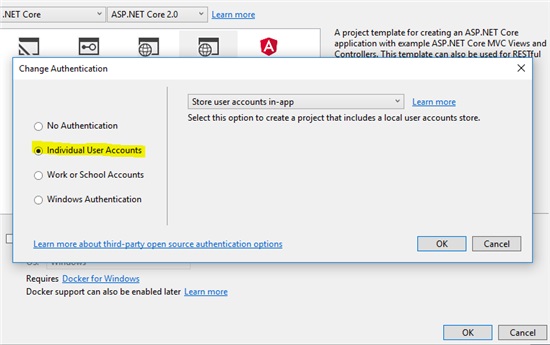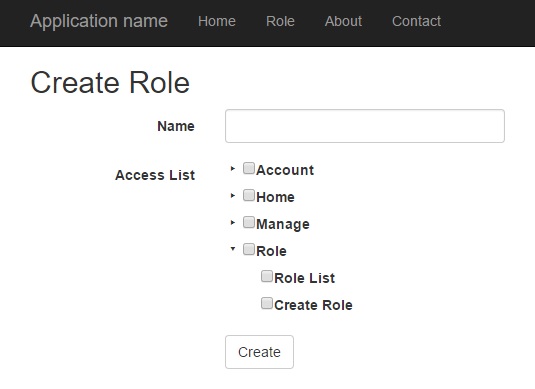Dynamic Role-Based Authorization in ASP.NET Core 2.0 and 3.1
You already know how role-based authorization wokrs in ASP.NET Core.
[Authorize(Roles = "Administrator")]
public class AdministrationController : Controller
{
}But what if you don't want hardcode roles in authorization attribute or create roles later and specify in which controller and action it has access without touching source code ?
Create ASP.NET Core Web Application project and change authentication to Individual User Accounts.
After creating project first thing we need is to find all controllers inside project. Add two new classes MvcControllerInfo and MvcActionInfo inside Models folder:
public class MvcControllerInfo
{
public string Id => $"{AreaName}:{Name}";
public string Name { get; set; }
public string DisplayName { get; set; }
public string AreaName { get; set; }
public IEnumerable<MvcActionInfo> Actions { get; set; }
}
public class MvcActionInfo
{
public string Id => $"{ControllerId}:{Name}";
public string Name { get; set; }
public string DisplayName { get; set; }
public string ControllerId { get; set; }
}Add another class MvcControllerDiscovery to Services folder to discover all controllers and actions:
public class MvcControllerDiscovery : IMvcControllerDiscovery
{
private List<MvcControllerInfo> _mvcControllers;
private readonly IActionDescriptorCollectionProvider _actionDescriptorCollectionProvider;
public MvcControllerDiscovery(IActionDescriptorCollectionProvider actionDescriptorCollectionProvider)
{
_actionDescriptorCollectionProvider = actionDescriptorCollectionProvider;
}
public IEnumerable<MvcControllerInfo> GetControllers()
{
if (_mvcControllers != null)
return _mvcControllers;
_mvcControllers = new List<MvcControllerInfo>();
var items = _actionDescriptorCollectionProvider
.ActionDescriptors.Items
.Where(descriptor => descriptor.GetType() == typeof(ControllerActionDescriptor))
.Select(descriptor => (ControllerActionDescriptor)descriptor)
.GroupBy(descriptor => descriptor.ControllerTypeInfo.FullName)
.ToList();
foreach (var actionDescriptors in items)
{
if (!actionDescriptors.Any())
continue;
var actionDescriptor = actionDescriptors.First();
var controllerTypeInfo = actionDescriptor.ControllerTypeInfo;
var currentController = new MvcControllerInfo
{
AreaName = controllerTypeInfo.GetCustomAttribute<AreaAttribute>()?.RouteValue,
DisplayName = controllerTypeInfo.GetCustomAttribute<DisplayNameAttribute>()?.DisplayName,
Name = actionDescriptor.ControllerName,
};
var actions = new List<MvcActionInfo>();
foreach (var descriptor in actionDescriptors.GroupBy(a => a.ActionName).Select(g => g.First()))
{
var methodInfo = descriptor.MethodInfo;
actions.Add(new MvcActionInfo
{
ControllerId = currentController.Id,
Name = descriptor.ActionName,
DisplayName = methodInfo.GetCustomAttribute<DisplayNameAttribute>()?.DisplayName,
});
}
currentController.Actions = actions;
_mvcControllers.Add(currentController);
}
return _mvcControllers;
}
}IActionDescriptorCollectionProvider provides the cached collection of ActionDescriptor which each descriptor represnts an action. Open Startup class and inside Configure method and register MvcControllerDiscovery dependency.
services.AddSingleton<IMvcControllerDiscovery, MvcControllerDiscovery>();It's time to add role controller to manage roles. In Controller folder create RoleController then add Create action:
public class RoleController : Controller
{
private readonly IMvcControllerDiscovery _mvcControllerDiscovery;
public RoleController(IMvcControllerDiscovery mvcControllerDiscovery)
{
_mvcControllerDiscovery = mvcControllerDiscovery;
}
// GET: Role/Create
public ActionResult Create()
{
ViewData["Controllers"] = _mvcControllerDiscovery.GetControllers();
return View();
}
}
Go to Models folder and add RoleViewModel class:
public class RoleViewModel
{
[Required]
[StringLength(256, ErrorMessage = "The {0} must be at least {2} characters long.")]
public string Name { get; set; }
public IEnumerable<MvcControllerInfo> SelectedControllers { get; set; }
}And in View folder add another folder and name it Role then add Create.cshtml view. I used jqeury.bonsai for showing controller and action hierarchy.
@model RoleViewModel
@{
ViewData["Title"] = "Create Role";
var controllers = (IEnumerable<MvcControllerInfo>)ViewData["Controllers"];
}
@section Header {
<link href="~/lib/jquery-bonsai/jquery.bonsai.css" rel="stylesheet" />
}
<h2>Create Role</h2>
<hr />
<div class="row">
<div class="col-md-6">
<form asp-action="Create" class="form-horizontal">
<div asp-validation-summary="ModelOnly" class="text-danger"></div>
<div class="form-group">
<label asp-for="Name" class="control-label col-md-2"></label>
<div class="col-md-10">
<input asp-for="Name" class="form-control" />
<span asp-validation-for="Name" class="text-danger"></span>
</div>
</div>
<div class="form-group">
<label class="col-md-3 control-label">Access List</label>
<div class="col-md-9">
<ol id="tree">
@foreach (var controller in controllers)
{
string name;
{
name = controller.DisplayName ?? controller.Name;
}
<li class="controller" data-value="@controller.Name">
<input type="hidden" class="area" value="@controller.AreaName" />
@name
@if (controller.Actions.Any())
{
<ul>
@foreach (var action in controller.Actions)
{
{
name = action.DisplayName ?? action.Name;
}
<li data-value="@action.Name">@name</li>
}
</ul>
}
</li>
}
</ol>
</div>
</div>
<div class="form-group">
<input type="submit" value="Create" class="btn btn-default" />
</div>
</form>
</div>
</div>
<div>
<a asp-action="Index">Back to List</a>
</div>
@section Scripts {
@{await Html.RenderPartialAsync("_ValidationScriptsPartial");}
<script src="~/lib/jquery-qubit/jquery.qubit.js"></script>
<script src="~/lib/jquery-bonsai/jquery.bonsai.js"></script>
<script>
$(function () {
$('#tree').bonsai({
expandAll: false,
checkboxes: true,
createInputs: 'checkbox'
});
$('form').submit(function () {
var i = 0, j = 0;
$('.controller > input[type="checkbox"]:checked, .controller > input[type="checkbox"]:indeterminate').each(function () {
var controller = $(this);
if ($(controller).prop('indeterminate')) {
$(controller).prop("checked", true);
}
var controllerName = 'SelectedControllers[' + i + ']';
$(controller).prop('name', controllerName + '.Name');
var area = $(controller).next().next();
$(area).prop('name', controllerName + '.AreaName');
$('ul > li > input[type="checkbox"]:checked', $(controller).parent()).each(function () {
var action = $(this);
var actionName = controllerName + '.Actions[' + j + '].Name';
$(action).prop('name', actionName);
j++;
});
j = 0;
i++;
});
return true;
});
});
</script>
}
It's time to save role but before that we need to do some changes.
- First create new class
ApplicationRoleinsideModelsfolder:
public class ApplicationRole : IdentityRole
{
public string Access { get; set; }
}- Open
ApplicationDbContextchange it to:
public class ApplicationDbContext : IdentityDbContext<ApplicationUser, ApplicationRole, string>- Open
Startupclass and insideConfiguremethod changeservices.AddIdentity...to:
services.AddIdentity<ApplicationUser, ApplicationRole>()
.AddEntityFrameworkStores<ApplicationDbContext>()
.AddDefaultTokenProviders();
- finally add new EF migration, in nuget Package Manager Console run
Add-Migration RoleAccessAddedcommand and new migration will be added toData->Migrationsfolder.
Go back to the RoleController and add post method of create action.
private readonly IMvcControllerDiscovery _mvcControllerDiscovery;
private readonly RoleManager<ApplicationRole> _roleManager;
public RoleController(IMvcControllerDiscovery mvcControllerDiscovery, RoleManager<ApplicationRole> roleManager)
{
_mvcControllerDiscovery = mvcControllerDiscovery;
_roleManager = roleManager;
}
// POST: Role/Create
[HttpPost]
[ValidateAntiForgeryToken]
public async Task<ActionResult> Create(RoleViewModel viewModel)
{
if (!ModelState.IsValid)
{
ViewData["Controllers"] = _mvcControllerDiscovery.GetControllers();
return View(viewModel);
}
var role = new ApplicationRole { Name = viewModel.Name };
if (viewModel.SelectedControllers != null && viewModel.SelectedControllers.Any())
{
foreach (var controller in viewModel.SelectedControllers)
foreach (var action in controller.Actions)
action.ControllerId = controller.Id;
var accessJson = JsonConvert.SerializeObject(viewModel.SelectedControllers);
role.Access = accessJson;
}
var result = await _roleManager.CreateAsync(role);
if (result.Succeeded)
return RedirectToAction(nameof(Index));
foreach (var error in result.Errors)
ModelState.AddModelError("", error.Description);
ViewData["Controllers"] = _mvcControllerDiscovery.GetControllers();
return View(viewModel);
}Selected controllers serialized into json and stored in role Access property. You can decorate controllers and actions with DisplayName attribute to show user more meaningful name instead of controller and action name.
[DisplayName("Access Management")]
public class AccessController : Controller
{
// GET: Access
[DisplayName("Access List")]
public async Task<ActionResult> Index()
}Next step is assigning roles to users. Add new view model and name it UserRoleViewModel and new controller AccessController. AccessController is straightforward has nothing complicated.
After assigning roles to users now we can check a user has permission to access a controller and action or not. Add new folder Filters then add new class DynamicAuthorizationFilter to the folder and DynamicAuthorizationFilter inherits IAsyncAuthorizationFilter.
public class DynamicAuthorizationFilter : IAsyncAuthorizationFilter
{
private readonly ApplicationDbContext _dbContext;
public DynamicAuthorizationFilter(ApplicationDbContext dbContext)
{
_dbContext = dbContext;
}
public async Task OnAuthorizationAsync(AuthorizationFilterContext context)
{
if (!IsProtectedAction(context))
return;
if (!IsUserAuthenticated(context))
{
context.Result = new UnauthorizedResult();
return;
}
var actionId = GetActionId(context);
var userName = context.HttpContext.User.Identity.Name;
var roles = await (
from user in _dbContext.Users
join userRole in _dbContext.UserRoles on user.Id equals userRole.UserId
join role in _dbContext.Roles on userRole.RoleId equals role.Id
where user.UserName == userName
select role
).ToListAsync();
foreach (var role in roles)
{
var accessList = JsonConvert.DeserializeObject<IEnumerable<MvcControllerInfo>>(role.Access);
if (accessList.SelectMany(c => c.Actions).Any(a => a.Id == actionId))
return;
}
context.Result = new ForbidResult();
}
private bool IsProtectedAction(AuthorizationFilterContext context)
{
if (context.Filters.Any(item => item is IAllowAnonymousFilter))
return false;
var controllerActionDescriptor = (ControllerActionDescriptor)context.ActionDescriptor;
var controllerTypeInfo = controllerActionDescriptor.ControllerTypeInfo;
var actionMethodInfo = controllerActionDescriptor.MethodInfo;
var authorizeAttribute = controllerTypeInfo.GetCustomAttribute<AuthorizeAttribute>();
if (authorizeAttribute != null)
return true;
authorizeAttribute = actionMethodInfo.GetCustomAttribute<AuthorizeAttribute>();
if (authorizeAttribute != null)
return true;
return false;
}
private bool IsUserAuthenticated(AuthorizationFilterContext context)
{
return context.HttpContext.User.Identity.IsAuthenticated;
}
private string GetActionId(AuthorizationFilterContext context)
{
var controllerActionDescriptor = (ControllerActionDescriptor)context.ActionDescriptor;
var area = controllerActionDescriptor.ControllerTypeInfo.GetCustomAttribute<AreaAttribute>()?.RouteValue;
var controller = controllerActionDescriptor.ControllerName;
var action = controllerActionDescriptor.ActionName;
return $"{area}:{controller}:{action}";
}
}IsProtectedActionchecks if requested controller and action hasAuthorizeattribute or not and if controller hasAuthorizeattribute, action hasAllowAnonymousattribute or not because we don't want check access on unprotected controllers and actions.IsUserAuthenticatedchecks user whether is authenticated or not and if user is not authenticatedUnauthorizedResultwill be returned.- then we fetch user roles and check if those roles has access to requested controller or not and if user has not access
ForbidResultwill be returned.
Now we need to register this filter golbaly in Startup class and modify services.AddMvc() to this:
services.AddMvc(options => options.Filters.Add(typeof(DynamicAuthorizationFilter)));That's it now we are able to create role and assign roles to user and check user access on each request.
And finally we need a custom TageHelper to check whether user has access to view links or not.
[HtmlTargetElement("secure-content")]
public class SecureContentTagHelper : TagHelper
{
private readonly ApplicationDbContext _dbContext;
public SecureContentTagHelper(ApplicationDbContext dbContext)
{
_dbContext = dbContext;
}
[HtmlAttributeName("asp-area")]
public string Area { get; set; }
[HtmlAttributeName("asp-controller")]
public string Controller { get; set; }
[HtmlAttributeName("asp-action")]
public string Action { get; set; }
[ViewContext, HtmlAttributeNotBound]
public ViewContext ViewContext { get; set; }
public override async Task ProcessAsync(TagHelperContext context, TagHelperOutput output)
{
output.TagName = null;
var user = ViewContext.HttpContext.User;
if (!user.Identity.IsAuthenticated)
{
output.SuppressOutput();
return;
}
var roles = await (
from usr in _dbContext.Users
join userRole in _dbContext.UserRoles on usr.Id equals userRole.UserId
join role in _dbContext.Roles on userRole.RoleId equals role.Id
where usr.UserName == user.Identity.Name
select role
).ToListAsync();
var actionId = $"{Area}:{Controller}:{Action}";
foreach (var role in roles)
{
var accessList = JsonConvert.DeserializeObject<IEnumerable<MvcControllerInfo>>(role.Access);
if (accessList.SelectMany(c => c.Actions).Any(a => a.Id == actionId))
return;
}
output.SuppressOutput();
}
}In each view wrap anchor tag inside secure-content tag:
<ul class="nav navbar-nav">
<li><a asp-area="" asp-controller="Home" asp-action="Index">Home</a></li>
<li><a asp-area="" asp-controller="Home" asp-action="About">About</a></li>
<li><a asp-area="" asp-controller="Home" asp-action="Contact">Contact</a></li>
<secure-content asp-area="" asp-controller="Role" asp-action="Index">
<li><a asp-area="" asp-controller="Role" asp-action="Index">Role</a></li>
</secure-content>
<secure-content asp-area="" asp-controller="Access" asp-action="Index">
<li><a asp-area="" asp-controller="Access" asp-action="Index">Access</a></li>
</secure-content>
</ul>
